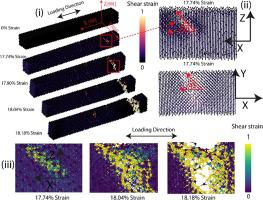当前位置:
X-MOL 学术
›
Comp. Mater. Sci.
›
论文详情
Our official English website, www.x-mol.net, welcomes your feedback! (Note: you will need to create a separate account there.)
Atomistic investigation on the mechanical properties and failure behavior of zinc-blende cadmium selenide (CdSe) nanowire
Computational Materials Science ( IF 3.3 ) Pub Date : 2021-01-01 , DOI: 10.1016/j.commatsci.2020.110001 Emdadul Haque Chowdhury , Md. Habibur Rahman , Rahul Jayan , Md Mahbubul Islam
Computational Materials Science ( IF 3.3 ) Pub Date : 2021-01-01 , DOI: 10.1016/j.commatsci.2020.110001 Emdadul Haque Chowdhury , Md. Habibur Rahman , Rahul Jayan , Md Mahbubul Islam

|
The mechanical properties of Cadmium Selenide (CdSe) nanowire is an emerging issue due to its application in semiconductor and optoelectronics industries. In this paper, we conducted molecular dynamics (MD) simulations to investigate the temperature-dependent mechanical properties and failure behavior of Zinc-Blende (ZB) CdSe nanowire under uniaxial tensile deformation. We employed Stillinger-Weber (SW) potential to describe the inter-atomic interactions. The effect of variation of temperatures (100 K-600 K), sizes, and crystal orientation on the tensile response of the CdSe nanowires is investigated. Our simulation results suggest that both ultimate tensile strength and Youngs modulus of CdSe have an inverse relationship with temperature. From 100K to 600K, the ZB CdSe exhibits brittle type failure thus there is no brittle to ductile transition temperature found. Results also suggest that size has a significant effect on the mechanical properties of CdSe nanowire. It has been found that as the cross-sectional area increases both ultimate tensile stress and Youngs modulus increases as well. The [111] oriented ZB CdSe shows the largest ultimate tensile strength, Youngs modulus and fracture toughness whereas the values are lowest for [100] orientation. The [110] orientation shows the largest failure strain compared to other orientations. Finally, failure mechanisms of CdSe nanowire are also investigated at 100K and 600K. We noticed that at 100K temperature [100] oriented ZB CdSe fails along {111} cleavage plane however in the case of 600 K temperature, both {111} and {100} planes are activated and cause fracture of CdSe nanowire at lower strain value. This study can guide to design ZB CdSe based solar cell, optoelectronic and semiconductor devices by presenting a comprehensive understanding of the mechanical and fracture characteristics of this nanowire.
中文翻译:

闪锌矿硒化镉(CdSe)纳米线力学性能和失效行为的原子学研究
硒化镉 (CdSe) 纳米线的机械性能由于其在半导体和光电子行业中的应用而成为一个新兴问题。在本文中,我们进行了分子动力学 (MD) 模拟,以研究闪锌矿 (ZB) CdSe 纳米线在单轴拉伸变形下的温度相关机械性能和失效行为。我们使用 Stillinger-Weber (SW) 势来描述原子间相互作用。研究了温度 (100 K-600 K)、尺寸和晶体取向的变化对 CdSe 纳米线拉伸响应的影响。我们的模拟结果表明,CdSe 的极限拉伸强度和杨氏模量都与温度成反比。从 100K 到 600K,ZB CdSe 表现出脆性破坏,因此没有发现脆性到韧性转变温度。结果还表明,尺寸对 CdSe 纳米线的机械性能有显着影响。已经发现,随着横截面积增加,极限拉伸应力和杨氏模量也增加。[111] 取向的 ZB CdSe 显示出最大的极限拉伸强度、杨氏模量和断裂韧性,而 [100] 取向的值最低。与其他方向相比,[110] 方向显示出最大的失效应变。最后,还研究了 CdSe 纳米线在 100K 和 600K 下的失效机制。我们注意到在 100K 温度下 [100] 取向的 ZB CdSe 沿 {111} 解理面失效,但是在 600 K 温度的情况下,{111} 和 {100} 平面都被激活并导致 CdSe 纳米线在较低应变值下断裂。本研究通过全面了解这种纳米线的机械和断裂特性,可以指导设计基于 ZB CdSe 的太阳能电池、光电和半导体器件。
更新日期:2021-01-01
中文翻译:

闪锌矿硒化镉(CdSe)纳米线力学性能和失效行为的原子学研究
硒化镉 (CdSe) 纳米线的机械性能由于其在半导体和光电子行业中的应用而成为一个新兴问题。在本文中,我们进行了分子动力学 (MD) 模拟,以研究闪锌矿 (ZB) CdSe 纳米线在单轴拉伸变形下的温度相关机械性能和失效行为。我们使用 Stillinger-Weber (SW) 势来描述原子间相互作用。研究了温度 (100 K-600 K)、尺寸和晶体取向的变化对 CdSe 纳米线拉伸响应的影响。我们的模拟结果表明,CdSe 的极限拉伸强度和杨氏模量都与温度成反比。从 100K 到 600K,ZB CdSe 表现出脆性破坏,因此没有发现脆性到韧性转变温度。结果还表明,尺寸对 CdSe 纳米线的机械性能有显着影响。已经发现,随着横截面积增加,极限拉伸应力和杨氏模量也增加。[111] 取向的 ZB CdSe 显示出最大的极限拉伸强度、杨氏模量和断裂韧性,而 [100] 取向的值最低。与其他方向相比,[110] 方向显示出最大的失效应变。最后,还研究了 CdSe 纳米线在 100K 和 600K 下的失效机制。我们注意到在 100K 温度下 [100] 取向的 ZB CdSe 沿 {111} 解理面失效,但是在 600 K 温度的情况下,{111} 和 {100} 平面都被激活并导致 CdSe 纳米线在较低应变值下断裂。本研究通过全面了解这种纳米线的机械和断裂特性,可以指导设计基于 ZB CdSe 的太阳能电池、光电和半导体器件。



























 京公网安备 11010802027423号
京公网安备 11010802027423号